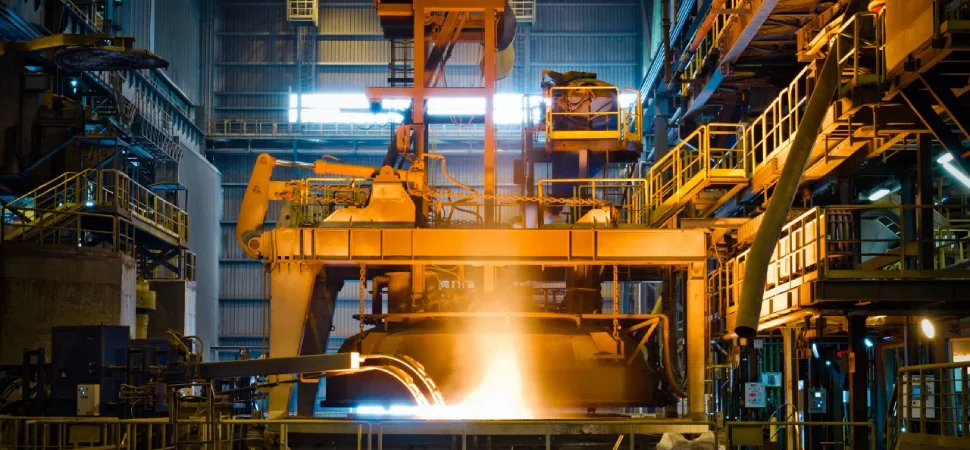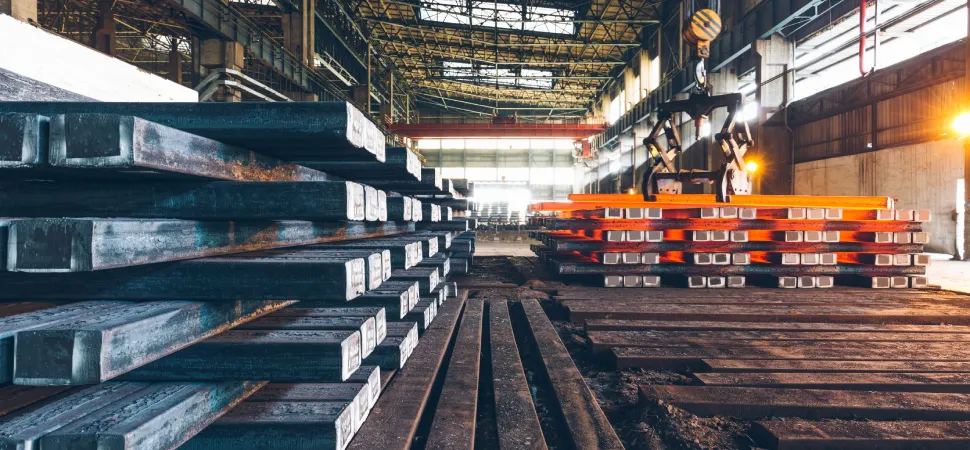Over the past two years, steel, used in a variety of everyday products such as cars, washing machines, building structures and surgical scalpels, has faced headwinds in its recovery from a prolonged slump.
Steel demand in China, which consumes more than half of the world's production, is slowing due to an inefficient and debt-ridden real estate sector. In addition, central bank monetary tightening is impacting housing demand and manufacturing activity, as well as global economic growth.
In this article, we analyze experts' views on the factors that will shape the steel price outlook in 2024, 2025 and beyond to 2030.
Key findings
The ongoing real estate crisis in China continues to put pressure on steel demand.
Stronger demand growth from the automotive industry and infrastructure investment could limit weakness in the real estate sector.
China's steel demand will decline over the next decade as dependence on heavy industry decreases.
Rising demand for renewable energy may support steel consumption in the long term.
The steel industry, like other raw materials and energy sectors, will experience a significant downturn in the first half of 2020 due to the COVID-19 pandemic.
Universal measures to contain the spread of the virus led to a decline in business activity and supply chain disruption. This caused a significant slowdown in residential and commercial construction, as well as the automotive industry, as people stayed home.
As a result, steel mills either temporarily closed or operated at reduced capacity during this period.
According to the Organization for Economic Cooperation and Development (OECD), prices for flat-rolled steel and rebar fell by 16% in July 2020.
However, the price decline was short-lived, as steel prices started to rise from July 2020 and continued to rise until July 2021. As of July 2021, flat and long steel prices have increased by 134% and 58%, respectively, year-on-year, according to the OECD's Q4 2021 Steel Market Report.
This sharp rise in prices is partly due to steel mills seeking to meet recovering demand and replenish their inventories after shutdowns at the start of the pandemic, according to the OECD report.
After peaking in June 2021, steel prices began to decline again.
According to the OECD report, in June 2022, flat and long steel prices fell 31% and 12%, respectively, from their peaks in June 2021. Long steel prices temporarily increased in April 2022 due to supply issues caused by sanctions against Russia following the invasion of Ukraine, but then returned to a downtrend.
According to the World Steel Association (Worldsteel), Russia is the sixth largest steel producer in the world.
By December 2022, flat-rolled steel and rebar prices were down 54% and 12%, respectively, year-on-year.
For example, the price of hot rolled coil (HRC) steel on a free-on-board (FOB) basis in China on the London Metal Exchange (LME) at the end of 2022 was about $645 per ton, down from about $750 in early January 2022 and from $950 in March following Russia's invasion of Ukraine in February.
Global steel prices generally stabilized in the first half of 2023, but there were variations across regions.
Flat-rolled steel prices were strong in the US, Europe and Japan due to robust demand, including from the automotive industry. In contrast, flat-rolled steel prices declined in China due to weak housing construction and deteriorating real estate investment, according to OECD data.
HRC steel futures in the US Midwest rose more than 52% year-on-year to 2023. At the same time, the price of Chinese HRC steel on a free-on-board (FOB) basis on the London Metal Exchange (LME) was around $576 per ton by the end of December 2023, down from nearly $650 per ton at the beginning of the year.
On the other hand, steel rebar futures for 2023 fell 9.76% to end the year at $600 per ton, down from $680 per ton at the beginning of the year.

Factors affecting steel prices in 2024
Most steel prices continue to decline in 2024. The price of steel HRC FOB China on the London Metal Exchange (LME) fell nearly 7% to $544.50 per tonne, down from $585 at the beginning of January. Rebar futures were down 2.7% at $583.5 per tonne as of May 1.
HRC domestic steel futures in the U.S. Midwest were down 28.63% at $810 per ton as of May 2.
Steel price trends since the beginning of the year
We take a look at some of the key factors that will drive steel prices through the end of 2024.
China's real estate sector remains in focus
The prolonged downturn in China's real estate sector is expected to continue to weigh on demand from the world's largest exporter and consumer of steel.
Crude steel production
Real estate companies in the country are facing high indebtedness due to excessive borrowing and large-scale construction. Despite government support measures such as lower mortgage rates and lower down payments for home buyers, signs of economic recovery remain slim.
In late January 2024, a Hong Kong court ordered the liquidation of Chinese real estate giant Evergrande after the company failed to provide an acceptable plan to restructure its $300 million debt, Al Jazeera reported.
In late February, another major Chinese real estate developer, Country Garden, announced it was facing liquidation for failing to repay a $205 million loan.
According to the National Bureau of Statistics, real estate companies sold 226.68 million square meters of new commercial buildings from January to March, down 19.4% year-on-year. Residential building sales fell 23.4% in the first three months.
During the same period, the area of buildings under construction totaled 6,785.01 million square meters, down 11.1% year-on-year. Of this volume, 4,745.80 million square meters accounted for residential buildings, also down 11.7%.
ANZ Research senior commodity strategist Daniel Hines and commodity strategist Soni Kumari suggested in a March 21 note that steel consumption in China's real estate sector will fall 4% to 270 million tons this year as the pace of real estate construction slows.
The real estate sector accounts for about 30% of China's domestic steel consumption. Hines and Kumari stated:
"We see no quick resolution to the problems in China's real estate market, and steel demand in the residential real estate sector is likely to continue to decline this year."
Fitch Ratings on March 1 predicted that residential real estate sales will fall to 850-900 million square meters in 2024 from 950 million square meters in 2023 and 1,150 million square meters in 2022.
Daria Efanova, head of research at London-based Sucden Financial, suggested in an April 17 webinar that a recovery in China's real estate construction is likely to begin in 2025.
Despite the expected decline in steel demand in China's real estate sector, analysts expect strong demand from infrastructure investment, the automotive industry (especially electric vehicle production), renewable energy and manufacturing to offset the slowdown in the construction sector.
Hines and Kumari of ANZ Research estimate that rising steel demand from other sectors will boost China's steel consumption by 0.5% year-on-year to 929 million tons in 2024.
According to ANZ Research, the infrastructure and automotive industries account for 25% and 10% of China's domestic steel consumption respectively. The analysts noted:
"Investment in social housing should increase. Infrastructure investment remains high, driven by government efforts to develop the renewable energy sector. China's auto industry, the world's largest, will receive further support, with a particular focus on the electric vehicle market. There is also growth in manufacturing, machinery and shipbuilding."
The World Steel Association, in its short-term forecast for April 2024, expects China's steel demand in 2024 to remain flat year-on-year at 895.7 million tons. This is due to rising demand from investment in the infrastructure and manufacturing sector, which will offset lower demand in the real estate sector.
However, Worldsteel forecasts China's steel demand to decline by 1% in 2025.
Global steel demand will recover slightly
Although steel demand in China is expected to remain low, other steel consuming countries are forecast to rebound, leading to an increase in global demand. However, this growth is limited by a number of factors, including declining household purchasing power, inflationary pressures, high costs, aggressive monetary tightening and geopolitical tensions.
Worldsteel forecasts steel demand to grow at a CAGR of 1.7% to reach 1,793 million tons in 2024. In 2025, the Brussels-based industry group estimates global steel demand will grow by 1.2% to 1,815 million tons.
Fitch Solutions' BMI predicted in its March 5 forecast that global steel consumption will grow by 2.1% to 953.441 million tons in 2024, compared with growth of 1.6% in 2023. However, tight financial conditions and inflationary pressures will continue to restrain this growth. Global consumption growth is expected to slow to 1.5% to 983.322 million tons in 2025 and 1.1% in 2026.
BMI analysts write:
"The global economic outlook remains gloomy, with the manufacturing sector continuing to hold back growth in developed markets. The ongoing conflict between Russia and Ukraine is expected to persist, further impacting the European Union's economic outlook and weighing on steel demand and prices."
The weak economy is limiting steel production growth. BMI estimates that global steel output will increase by a modest 2% to 925.661 million tons after production is flat in 2023 due to weakness in the global economy. In 2025, global steel production growth is forecast to increase by 1.6% to 956.361 million tons and by 1.2% to 979.81 million tons in 2026.
"We also note that downside risks remain as a deteriorating global industrial and economic outlook will weigh on steel production," BMI analysts wrote in their steel price forecast.
In the first three months of 2024, global steel production rose 0.5% year-on-year to 469.1 million tons.
ANZ Research, in its latest forecast on May 2, expects the global economy to grow at 3.1% in 2024, little changed from 3.2% in 2023. Meanwhile, the bank estimates China's economic growth will slow to 4.9% in 2024 and 4.5% in 2025.
The end of monetary tightening
Monetary tightening between 2022 and 2023 impacted demand for base metals, including steel, as high interest rates increased the cost of mortgages and loans, leading to a downturn in housing and manufacturing activity.
Investors are closely watching the actions of central banks, especially the U.S. Federal Reserve, in completing the monetary tightening cycle in 2024. On March 21, the Swiss National Bank surprised markets by cutting its benchmark interest rate by 0.25 percentage point to 1.5%. The European Central Bank and the Fed also said they may lift monetary restrictions once inflation returns to target levels.
In its short-term forecast, Worldsteel noted:
"While the global economy is likely to experience a soft landing after this cycle of monetary tightening, we expect global steel demand growth to remain weak and market volatility to remain high due to the lagged impact of monetary tightening, high costs and high geopolitical uncertainty."
Nevertheless, Worldsteel believes that faster-than-expected disinflation accompanied by further monetary easing could provide a significant boost to sectors that rely heavily on steel, particularly housing.

Steel price forecast for 2024
- BMI from Fitch Solutions $740.
- Trading Economics 3,448.29 yuan ($476.32)/mt (steel rebar futures on the Shanghai Futures Exchange) end 2Q.
- Trading Economics $785.35/mt (domestic HRC steel in the US Midwest) end 2Q.
Steel demand in China is likely to remain weak, which will restrain the recovery in global steel consumption. Against this backdrop, Fitch Solutions' BMI forecasts that average steel prices will average $740/MT in 2024, up 1.4% from $730 in 2023.
BMI analysts note that prices will be subject to volatility in the coming months and market sentiment will be heavily influenced by China's stimulus measures. The downturn in China's real estate sector will continue to put downward pressure on steel prices. Analysts suggest that this downturn, caused by oversupply on the back of lower speculative demand, could last for several years.
BMI added that if China's economic momentum remains weak in 2024, steel prices could fall below current expectations. On a global level, a deep recession in the US could lead to a significant decline in US steel prices, which in turn would lower the global average price level.
Trading Economics estimates that steel rebar futures on the Shanghai Futures Exchange will reach 3,448.29 yuan ($476.32)/mt, while domestic HRC steel in the US Midwest will trade at $785.35/mt.
Haikal Hubais, secretary general of the Indonesian Downstream Industry Association, said steel prices could recover in the second half of 2024. He pointed out that investment in infrastructure and manufacturing in China is expected to increase, as well as steel demand in India. Although Hubays did not provide a specific steel price forecast, he expressed optimism for an improvement in the second half of the year.
Steel price forecast for 2025
- BMI by Fitch Solutions $730.
- Trading Economics 3,317.65 yuan ($458.30)/mt (steel rebar futures on the Shanghai Futures Exchange) 12 months from the end of 2Q 2024.
- Trading Economics $713.26/mt (domestic HRC steel in the US Midwest) 12 months after the end of 2Q 2024.
- Steel prices are forecast to decline in 2025, partly due to an expected slowdown in steel demand in China.
BMI forecasts the average steel price in 2025 to be $730/mt, down 1.4% from the 2024 estimate of $740/mt. BMI analysts note:
"Ultimately, we expect the combination of slowing steel consumption growth in China and increased protectionism in the global steel market encouraging increased production in affected countries to weaken the market and lead to lower prices in the medium term."
Worldsteel also forecast a decline in China's steel demand in 2025, noting that it will be significantly lower than the peak year of 2020. The organization stated:
"This forecast is also consistent with our view that China may have reached its peak steel demand, and the country's steel demand is likely to continue to decline in the medium term as China gradually shifts away from an economic development model that relies on investment in real estate and infrastructure."
Thus, global steel prices are expected to remain under pressure due to weakening Chinese demand and increased protectionism in other countries, leading to increased domestic production and reduced reliance on imports.
Steel price forecast for 2030
Analysts rarely provide long-term steel price forecasts because such forecasts depend on many complex and unpredictable factors. However, BMI estimates that steel prices may continue to decline in the coming years, reaching an average of $540/mt by 2030 and $520/mt by 2033.
The estimated decline in steel prices is attributed to the continued slowdown in domestic demand in China. The world's second largest economy is looking to reduce its reliance on heavy industry and shift to the service sector, especially after the collapse of the real estate bubble. BMI notes:
"Stronger demand growth in India and possibly other emerging markets is unlikely to offset the net effect of China's slowdown."
Thus, the outlook for the next decade suggests a decline in steel prices, driven by structural changes in the Chinese economy and the limited ability of other emerging markets to offset this decline in demand.
Bottom line
Agreed, steel price forecasting is a complex task given the many variables, including macroeconomic conditions, changes in consumer demand and technological innovation. China's real estate crisis and a general slowdown in the global economy could put pressure on steel prices in the coming years. However, the global race to decarbonize the economy, including the shift to renewable energy and electric vehicles, could support steel demand in the long term.
It is important to remember that forecasts and forecasters can be wrong and the steel market can be subject to significant fluctuations. Before making decisions to invest in steel or any other asset, it is recommended that you conduct your own research and consult with financial professionals to tailor your investment strategies to your own financial goals and level of risk.
FAQ
Q: Is steel a good investment?
A: The steel price forecasts cited in this article suggest that long-term prices for the metal may decline due to a potential decline in demand from China, the world's leading steel consumer and producer. If you are considering adding steel to your investment portfolio, conducting thorough research on the steel market is critical. Analysts may have made mistakes in their forecasts.
Q: Will steel go up or down?
A: BMI predicts that steel prices could rise to $740 in 2024 and then continue a downward trend over the next decade to reach $520 by 2033.
Q: Should I invest in steel?
A: Investing in commodities, whether through futures exchanges or by purchasing exchange-traded funds (ETFs), can provide an alternative to traditional investments such as stocks and bonds. However, it is important to remember that commodities can be very volatile due to factors such as weather and economic growth. Before investing in steel, think about your risk profile and investment goals.




Comments